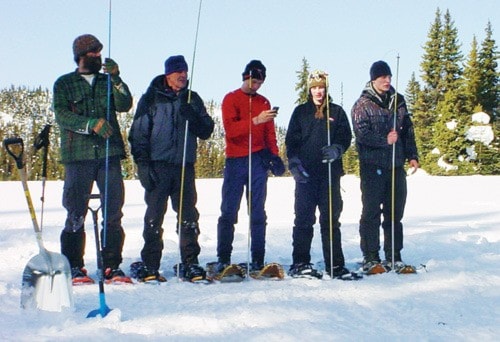Nine search-and-rescue volunteers woke up with all their ninety toes after a recent winter camp.
Building a winter shelter is a key test for new recruits on Houston’s search and rescue team, says coordinator Frank McDonald, and a challenge they all look forward to.
When they set out March 23 to a high point about 30 km down Equity Mine Road, the group expected lows between -10 C and -15 C. Everyone carried food, a shovel, and fire-starting gear—the sort of set-up snowmobilers or skiers might have if they got lost.
McDonald said everyone camped 50 to 100 metres apart and dug in for the night in different ways. Some shovelled out tree wells and threw tarps over top. Others built lean-to’s by a fire.
“Most of them realized the energy spent maintaining a fire overnight meant more energy was wasted than crawling into a sleeping bag and hopefully staying warm,” he said.
One person built a snow cave, a shelter McDonald says requires too much forethought and time to use in a real emergency, noting that it can take hours for the snow mounds to settle.
For new recruit Tim Van Leeuwen, the March 23 test was his first winter camp-out.
“I really enjoyed it,” he said, adding that next time he’ll do at least one thing differently—bring a wider shovel.
When the sun rose on the cold campers, McDonald said they found the best warm-up was to simply get up and stomp around.
With blood flowing again, they started on compass drills (difficult when you need to pace your steps in snowshoes) and an avalanche rescue.
For the rescue, McDonald buried a dummy with a beacon stuck on “send.” The team honed in and dug it out using beacons and probes.
McDonald says beacons are easy for anyone to use, but it’s worth trying one out before an emergency.
“They come with directions, but the best thing to do is practice,” he said. “I’ve done it in my backyard—get someone to hide a beacon and go out and try to find it.”
